Abstract
1. Introduction
Extensive research shows that, under certain circumstances, groups can be far more productive when they use group support systems (GSS) than when they do not [see 8, 9, for overview of GSS Research]. Such productivity increases may increase the likelihood that organizations will survive and thrive. However, increases in group productivity are not always accompanied by increases in meeting satisfaction and research shows that people who find their GSS experience unsatisfying may not use GSS for subsequent tasks [19], thereby losing the benefits it can provide to their organization and to society. Meeting satisfaction is an affective arousal with a positive valance on the part of a participant toward a meeting -a good feeling about the meeting.
Many GSS researchers have collected data on meeting satisfaction along with data on group productivity. In some studies, treatments that produced higher levels of productivity resulted in higher levels of meeting satisfaction as well [7],[11],[20]. In other studies, treatments that produced higher levels of productivity resulted in lower levels of meeting satisfaction [5],[14], or non-significant differences in meeting satisfaction [6],[10],[11],[12],[17],[21],[23],[24].
Conflicting research results on meeting satisfaction in GSS literature have never been fully explained. An explanatory theory of meeting satisfaction may illuminate the underlying causes of seemingly conflicting research results, and might make it possible for researchers and practitioners to develop systems and methodologies that increase group efficiency and group effectiveness, without decreasing meeting satisfaction. This paper derives Satisfaction Attainment Theory (SAT), a causal model of meeting satisfaction. It then presents a survey instrument for measuring the constructs in the model, and argues the statistical validity of the instrument. Next, it analyzes the results of a field study that tests the propositions of SAT. Finally, the paper discusses the implications of the findings for research and practice, and proposes directions for follow-on research.
2. Satisfaction Attainment Theory (SAT)
Satisfaction Attainment Theory is a causal model of meeting satisfaction. SAT is based on four assumptions.
Assumption 1:
Individuals hold multiple goals.
A goal is an outcome or state that an individual wishes to achieve. Examples of goals that are outcomes include a job promotion and home ownership. Examples of goals that are states include good health and loving family relationships. The desirability of goals varies and, in general, the strength of desire for a particular goal is a function of the value an individual places on attaining that goal. Because human attention resources are limited, we expect that individual's are only aware of a subset of their goals at any one time. Goals that individuals are aware of at the present moment are said to be salient.
Assumption 2:
The goals held by individuals may be conflicting or mutually excusive.
Individuals often find themselves with conflicting goals, such as meeting a project deadline or taking a family vacation. Sometimes the goals are mutually exclusive. For example, an individual with the goal of becoming a Catholic priest and the goal of having a spouse and children is faced with a situation in which the attainment of one goal necessarily prohibits the attainment of the other goal. When people consider salient goals, they must often balance the value of attaining one goal against the value of attaining others.
Assumption 3:
Awareness of a set of goals is accompanied by Perceived Net Goal Attainment (PNGA).
Individuals analyze their salient goals in terms of their value and likelihood of attainment. PNGA refers to the change in the judgment of the value and likelihood of a set of salient goals that takes place from one time period to the next, such as the duration of a meeting. When individuals perceive that the value of goals that have been, or are likely to be, attained exceed the value of goals that have been, or are likely to be, thwarted they should experience a positive degree of PNGA. Likewise, when individuals perceive that the value of goals that have been, or are likely to be, attained are exceeded by the value of goals that have been, or are likely to be, thwarted they should experience a negative degree of PNGA. PNGA is directly impacted by the probability of goal attainment. For example, PNGA may be greater if less-valued goals are perceived as eminently attainable than if high-valued goals are perceived as having a low probability of attainment. It is also recognized that attaining goals costs resources such as time and effort. Thus, it is assumed that individuals share the goal of optimizing their time and effort at varying degrees of desirability.
Assumption 4:
PNGA is accompanied by an affective arousal that is proportional to the magnitude of the PNGA, and valanced in the direction of PNGA.
If one's assessment of the likelihood and value of salient goals holds at a constant state from one time period to the next (and thus PNGA equals zero), then it would be unlikely that affective arousal would manifest in the duration. However, if the assessment of the likelihood and value of salient goals does change, then it would cause an affective arousal. Such affective arousal would be positively valanced if PNGA is positive and negatively valanced if PNGA is negative. For example, if one had a lofty goal with high value but low likelihood, such as writing a best selling novel, failure to achieve that goal would be unlikely to cause affective arousal in the short term because PNGA would be close to zero with respect to that goal. If, however, that person were to look back at the end of their life and realize they never achieved the goal, it then could produce affective arousal as the likelihood has completely diminished and thus caused a negative value of PNGA with respect to the goal of writing a best selling novel. If one wished to drive to the grocery store, and was completely confident of success, one might not feel affective arousal about success because PNGA would be largely unaffected. If, however, one wishes to earn a doctorate, success is not assured. Passing preliminary exams raises the probability of success, creating positive PNGA, which may give rise to a positively valanced affective arousal. However, successfully defending ones dissertation might be anti-climactic for one who was fully certain of success, because success would not alter PNGA despite the occurrence of goal attainment. But if someone struggled through a doctorate program, then a successful defense would raise the probability of attainment substantially. Such an event may cause high PNGA and would give rise to a large positively valanced affective arousal.
If the assumptions of SAT hold, then the satisfaction (affective arousal with a positive valance) one felt after a meeting would be a function of the perception that, balancing conflicting and mutually exclusive goals, the value of ones goals increased, or the likelihood of their success increased because of the meeting. Meetings that produce positive PNGA should also produce high levels of meeting satisfaction and meetings that produce negative PNGA should also produce low levels of meeting satisfaction.
There are at least two aspects of a meeting with which a person could feel satisfaction: (1) the meeting outcomes and (2) the process by which the outcomes were attained. Satisfaction with meeting outcome (SO) is defined as an affective arousal with a positive valance on the part of a participant with respect to that which was created or achieved in a meeting. Satisfaction with meeting process (SP) is defined as an affective arousal with a positive valance on the part of a participant with respect to the procedures and tools used in a meeting.
Based on the assumptions of SAT, we propose the following:
Proposition 1:
Satisfaction with meeting outcomes is a direct function of the perceived net goal attainment (PNGA) resulting from the meeting outcomes.
Proposition 2:
Satisfaction with meeting process is a direct function of the perceived net goal attainment (PNGA) resulting from the meeting process.
People may feel satisfied with the outcome or process of a meeting to the degree that they believe the outcomes or process has increased their likelihood of attaining their salient goals, and/or to the degree that they believe the outcomes or process increased the value of their salient goals.
A relationship between SO and goal attainment has already been demonstrated in the literature. Castore and Mumighan [4], and subsequently Reinig [18], report positive correlations between relative individual goal attainment, measured as the similarity between an individual's preferences and a group's preferences, and satisfaction with group decision. Those findings focus on satisfaction with a decision, a particular type of meeting outcome, and they measured goal attainment, which is often an instance of increased PNGA. If a person is uncertain of goal attainment, then success would likely constitute an increase in PNGA, because at least one goal has increased in likelihood (i.e., that goal that was attained changed from uncertain attainment to certain attainment). However, if participants were certain of goal attainment, then the attainment event should not have given rise to feelings of satisfaction. The studies conducted by Castore and Mumighan [4] and Reinig [18] both used experimental tasks that produced variation in relative individual goal attainment, which likely also produced variation in PNGA.
SO and SP must, in part, be independent of one another. For example, a highly politicized, grindingly dull policy session (low SP) may nonetheless produce an elegantly satisfying policy (high SO). Likewise the dedicated members of a budget committee may feel satisfied that they gave their highest and best efforts in service of their organization (high SP), but still find no solution to forestall a pending bankruptcy (low SO).
However, one important goal people usually hold for a meeting process is that it produces a satisfactory outcome. Therefore, in part, it must be that:
Proposition 3:
Satisfaction with process is a direct function of satisfaction with outcome.
Figure 1 illustrates the propositions of SAT.
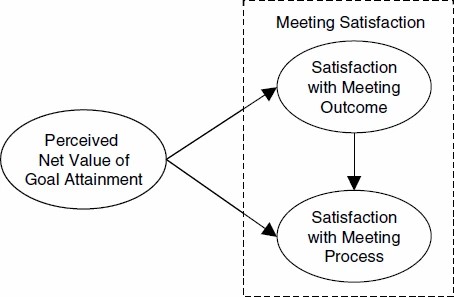
Figure 1.Figure 1.
SAT suggests some possible explanations for the seemingly conflicting results in the exploratory meeting satisfaction data that many GSS researchers have collected along with their measures of productivity. Part of the conflict may spring from the design of experimental tasks. If meeting satisfaction is caused by PNGA, then participants with no stake in the experimental task would not be likely to express high meeting satisfaction, regardless of the outcome. For example, a university student participating in a brainstorming task on the topic, “What useful things can you do with an old spark plug?” might not experience positive PNGA regardless of how many creative ideas were generated. Another student in the same task might report high meeting satisfaction because, by participating, she received extra credit in a required course, and so was able to raise her grade (positive PNGA with respect to the goal of academic success). Such an outcome would be consistent with SAT, but may have little to do with experimental treatments. The failure of experimental tasks to impact PNGA may explain why the majority of meeting satisfaction findings in GSS laboratory research have been non-significant.
SAT suggests that another part of the conflict in meeting satisfaction results may have been caused by a confounding of SO and SP. If exploratory data were collected with instruments that lumped SO and SP in a single satisfaction variable, it is possible that experimental treatments had differential effects on SO and SP, yielding aggregate results that were difficult to explain.
Therefore, a rigorous test of the propositions of SAT requires a measurement instrument that clearly distinguished between SO and SP and an experimental task where participants would be likely to have a stake in the outcome, and therefore also in the process. The next section of this paper describes the development and validation of a questionnaire instrument to measure the constructs of SAT. The following section presents an empirical test of the SAT model.
3. Measuring Meeting Satisfaction
To test SAT, we required a general purpose instrument to measure PNGA, SO, and SP.
Green and Taber [13] published a robust and reliable instrument for measuring solution satisfaction (an
instance of SO) and decision scheme satisfaction (an instance of SP), which was used
in a number of studies [e.g., [1],[2],[15],[16]. However, the questions on their instrument are only useful for measuring meetings
where the outcome is a decision. Further, many of the items in the Green and Taber
[13] instrument focus on a different meaning of the word, “satisfaction” than does SAT.
The difference between the two perspectives can be illustrated with these two statements:
The first statement is a judgment of requirements fulfilled. The second expresses an emotional response. Most of the Green and Taber instrument investigates judgments of requirements fulfilled, asking whether certain goals were attained (e.g. efficiency, coordination, understanding). To test SAT, we needed an instrument to measure affective responses to meeting outcomes, affective responses to meeting processes, and PNGA. Toward that end we developed and refined a set of fifteen questions, five for each of the three constructs in SAT (Appendix).
Because SAT frames satisfaction as an affective arousal, questions about SP and SO explicitly ask questions about feelings towards meeting process or meeting outcomes. Because SAT frames the cause of satisfaction as PNGA, questions about PNGA could only be answered positively if the meeting increased the value of goals or increased the probability of goal attainment.
Having developed the questions in English, we translated them into Dutch because we had a rare and valuable opportunity to collect responses from working professionals in The Netherlands from meetings in which they had a high vested interest. The instrument was translated into Dutch by a native speaker. To validate the translation, it was translated back to English from Dutch by a professional translator. The meanings of the reverse translated questions corresponded well with the original English wordings. We then collected responses from 156 working professionals in the Netherlands using the Dutch version of the instrument. Out of 156 questionnaires, five were discarded from the analysis because at least one of the items measuring PNGA, SO or SP were not completed. Of the remaining 151, there were 117 males and thirty-one females (three did not indicate their gender on the survey). The average age of the participants was 40.6 years (sd 10.0) and they had an average of 16.7 years (sd 10.3) working experience. There were eleven groups and group size ranged from seven to twenty-five with an average of 13.7 (sd 4.7). All groups used GroupSystems by GroupSystems.com in their meetings.
The data was first tested for discriminant and construct validity. The results of exploratory factor analysis are reported in Table 1. The result supports a three-factor model in which all items that measure the same construct load heavily on a single factor. Further, no item loads heavily on a factor that includes items from another construct. The Cronbach's a statistics indicated high reliability, as all were 0.94 or higher (Table 1).
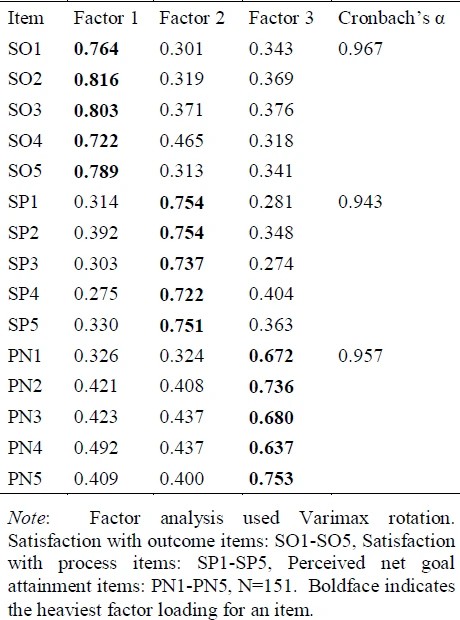
A confirmatory factor analysis using AMOS 4.01 was then conducted. The factor loadings are presented in Figure 2 and the corresponding fit measures are presented in Table 2. The test was significant, but the ratio was 1.92, well below the upper threshold of 5.00 recommended by Wheaton et al. [22]. The fit measures suggested adequate fit as well: GFI=0.88, AGFI=0.83, CFI=0.97, and NFI=0.95. The root mean squared error of approximation (RMSEA) was 0.077, which is considered adequate as well [3]. Thus, the instrument was successfully validated using both exploratory and confirmatory factor analysis.
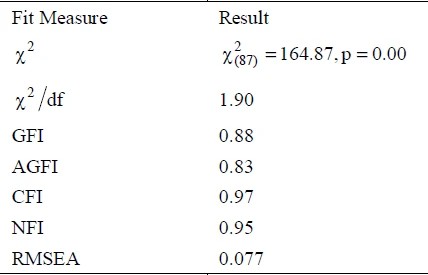
4. Validation of SAT
The three propositions of SAT, presented above, were developed into hypotheses in order to test SAT. The hypotheses correspond directly to the propositions as follows:
- Participants reporting higher levels of PNGA will report higher levels of SO.
- Participants reporting higher levels of PNGA will report higher levels of SP.
- Participants reporting higher levels of SO will report higher levels of SP.
SEM was then used to test the path diagram depicted in Figure 1 along with the three hypothesized path coefficients. The fit measures were identical
to those of the confirmatory factor analysis (Table 2) and thus the overall fit of the model was deemed adequate. The standardized parameter
estimates were then examined for hypothesis testing and all three hypotheses were
supported (Table 3). The parameter from PNGA to SO (hypothesis 1) was significant at and explained 72.3 percent of the variance in SO. The parameter from PNGA to SP (hypothesis
2) was significant at and explained 41.0 percent of the variance in SP. The parameter from SO to SP (hypothesis
3) was significant at and explained only 5.8 percent of the variance in SP. Thus, the overall model and
the three hypothesized relationships were supported by the analysis.
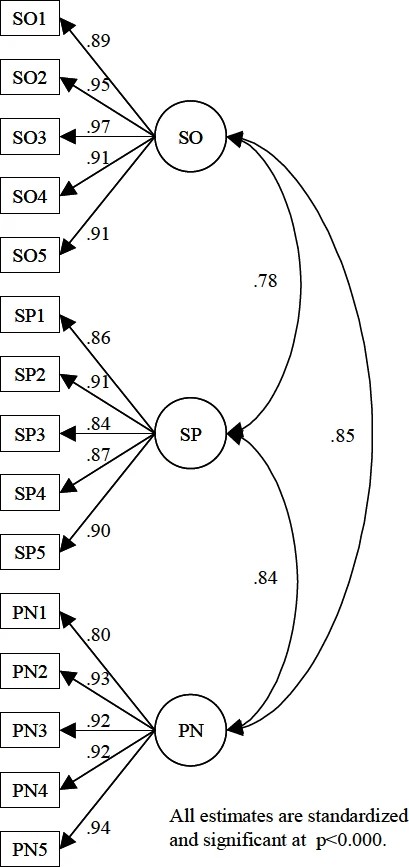
Figure 2.Figure 2.
The strongest relationship in the model was between PNGA and SO. This is not unexpected because the outcomes of meetings are likely to directly impact goal attainment. If the outcomes are favorable for an individual, meaning positive PNGA, then SO should manifest as well. However, if the outcomes are unfavorable, meaning a negative PNGA, then SO should be low as well. Meetings that fail to produce a meaningful outcome may lower PNGA because the goal to optimize one's resources effectively is thwarted. Thus, to the extent that the outcomes of a meeting are inline with an individual's salient goals, a strong relationship between PNGA and SO should be expected in meetings in which the participants have a vested interest in the outcome, such as the case here.
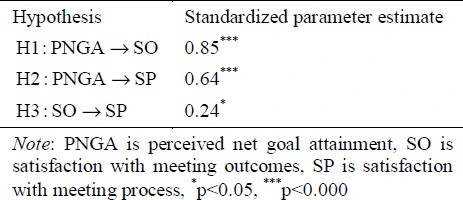
The next strongest relationship was between PNGA and SP. This relationship may be strengthened further in instances where individuals believe that the tools and procedures used in the course of a meeting could be used again in the future to further increase PNGA. Finally, the relationship between SO and SP was by far the weakest of the three as SO explained only a small portion of the variance in SP. This is to be expected given that PNGA accounts for a large portion of the variance in SP and that the single goal represented by the relationship between SO and SP is only one of multiple salient goals. Nevertheless, the finding does reveal that distinct portions of the variance in SP are explained seperately by PNGA and SO.
5. Future Research on Meeting Satisfaction
The findings of this study have a number of implications for future research examining the meeting satisfaction construct. First, it is important to adequately define meeting satisfaction and identify its dimensionality. We have defined meeting satisfaction as an affective arousal with a positive valance on the part of a participant towards a meeting. However, other researchers may choose to define meeting satisfaction differently, such as the degree to which a meeting has fulfilled certain requirements. Failure to provide a clear definition of meeting satisfaction reduces the degree to which research on meeting satisfaction can be generalized.
Second, if meeting satisfaction is defined in terms of affective arousal, then it is important to also distinguish between satisfaction with meeting outcomes and satisfaction with meeting process. It is entirely possible that certain collaborative technologies could produce high levels of one dimension, such as satisfaction with meeting outcomes, without producing high levels of the other dimension, such as satisfaction with meeting process.
Third, it is important to theorize about PNGA when investigating meeting satisfaction. For example, interventions and technology that increase the salience of goals that are favorably impacted by a meeting would tend to increase PNGA which would, in turn, increase SO and SP. However, students participating in laboratory experiments may find their PNGA largely unaffected by the variance in experimental outcome. In such cases, researchers may be in a better position to draw conclusions about other constructs, such as group productivity, than meeting satisfaction. Experimental attempts to manipulate meeting satisfaction should directly examine the impact of the experiment on PNGA.
We encourage researchers to adopt these aforementioned strategies when investigating meeting satisfaction in the lab or the field. Such action may improve the consistency that GSS researchers are able to accurately hypothesize about the influence of various applications and experimental conditions on meeting satisfaction.
6. Conclusion
Meeting satisfaction is an important measure of collaboration technology effectiveness. In this paper we have derived Satisfaction Attainment Theory (SAT), which suggests that PNGA causes SO and SP and that SO causes SP independent of PNGA. An English and Dutch version of a questionnaire to measure PNGA, SO, and SP is presented in Appendix A. The Dutch version was validated with responses from 151 working Dutch professionals in The Netherlands. SAT was also validated using the same data set. SAT should prove useful to researchers interested in the meeting satisfaction construct and methods for applying SAT to future research are presented.
References
- [1]Alavi, M. , Yoo, Y. , and Vogel, D.R. “Using information technology to add value to management education” Academy of Management Journal, 40, 6 (December1997), 1310–1333.
- [2]Andres, H.P. , and Zmud, R.W. “A contingency approach to software project coordination” Journal of Management Information Systems, 18, 3 (Winter 2001-2002), 41–70.
- [3]Browne, M.W. , and Cudeck, R. , “Alternative ways of assessing model fit,” In Bollen, K.A. and Long, J.S. (Eds.). Testing Structural Equation Models. Newbury Park, CA: Sage, 1993.
- [4]Castore, C.H. , and Murnighan, J.K. , Determinants of support for group decisions, Organizational Behavior and Human Performance, 22, 1 (August1978), 75–92.
- [5]Connolly, T. ; Jessup, L. ; and Valacich, J.S. Effects of anonymity and evaluative tone on idea generation in computer-Mediated groups. Management Science, 36, 6 (1990), 689–703.
- [6]Dennis, A.R. Information exchange and use in group decision making: you can lead a group to information but you can't make it think. MIS Quarterly, 20, 4 (1996) 433–455.
- [7]Easton, A.C. ; Vogel, D.R. ; and Nunamaker, J.F. Stakeholder Identification and assumption surfacing in small groups: an experimental study. Proceedings of the Twenty-Second Hawaii International Conference on System Sciences, 3 (1989), 344–351.
- [8]Fjermestad, J. , and Hiltz, S.R. An assessment of group support systems experimental research: methodology and results. Journal of Management Information Systems, 15, 3(Winter 1998-1999), 7–149.
- [9]Fjermestad, J. and Hiltz, S.R. Group support systems: A descriptive evaluation of case and field studies. Journal of Management Information Systems, 17, 3 (Winter 2000), 112–157.
- [10]Gallupe, R.B. ; Cooper, W.H. ; Grise, L.M. ; and Bastianutti, L.M. Blocking electronic brainstorms. Journal of Applied Psychology, 79, 1 (1994), 77–86.
- [11]Gallupe, R.B. ; Dennis, A.R. ; Cooper, W.H. ; Valacich, J.S. ; Bastianutti, L.M. ; and Nunamaker, J.F. Jr., Electronic brainstorming and group size. Academy of Management Journal, 35, 2 (June1992), 350–369.
- [12]George, J.F. ; Dennis, A.R. ; and Nunamaker, J.F. An experimental investigation of facilitation in an EMS decision room. Group Decision and Negotiation, I (1992), 57–70.
- [13]Green, S.G. , and Taber, T.D. , The effects of three social decision schemes on decision group process, Organizational Behavior and Human Performance, 25, 1 (February1980), 97–106.
- [14]Kerr, D.S. , and Murthy, U.S. , Group decision support systems and cooperative learning in auditing: an experimental investigation, Journal of Information Systems, 18, 2 (1994), 85–96.
- [15]Mennecke, B.E. , and Valacich, J.S. Information is what you make of it: the influence of group history and computer support on information sharing, decision quality, and member perceptions, Journal of Management Information Systems, 15,2 (Fall 1998), 173–197.
- [16]Miranda, S.M. , and Bostrom, R.P. , Meeting facilitation: Process versus content interventions, Journal of Management Information Systems15, 4 (Spring 1999), 89–114.
- [17]Olson, J.S. ; Olson, G.M. ; Storrosten, M. ; and Carter, M. How a group-Editor changes the character of a design meeting as well as its outcome. Proceedings of the Conference on Computer-Supported Cooperative Work (October 1992), 91–98.
- [18]Reinig, B.A. An Investigation of Meeting Satisfaction in GSS and FTF Meetings” Thirty-Fifth Hawaii International Conference on System Sciences, (2002), 1–10.
- [19]Reinig, B.A. ; Briggs, R.O. ; Shepherd, M.M. ; Yen, J. ; and Nunamaker, J.F. , Jr.Affective reward and the adoption of group support systems: productivity is not always enough. Journal of Management Information Systems, 12, 3 (Winter 1995-1996), 171–185.
- [20]Steeb, R. , and Johnston, S.C. A computer-Based interactive system for group decision making. IEEE Transactions on Systems, Man, Cybernetics, 11, 8 (1981), 544552.
- [21]Valacich, J.S. ; Dennis, A.R. ; and Connolly, T. Idea generation in computer-Based groups: a new ending to an old story. Organizational Behavior and Human Decision Processes, 57 (1994), 448a67.
- [22]Wheaton, B. , Muthén, B. , Alwin, D.F. , and Summers, G.F. Assessing reliability and stability in panel models. In Heise, D.R. (Ed.)Sociological Methodology, San Francisco: Jossey-Bass, 1977.
- [23]Wilson, J. , and Jessup, L.M. A field experiment on GSS anonymity and group member status. Proceedings of the Twenty-Eighth Hawaii International Conference on System Sciences, 4 (1995), 212–221.
- [24]Wood, J.G. , and Nosek, J.T. Discrimination of structure and technology in a group support system: the role of process complexity. Proceedings of the International Conference on Information Systems, 3 (1994), 187–199.

